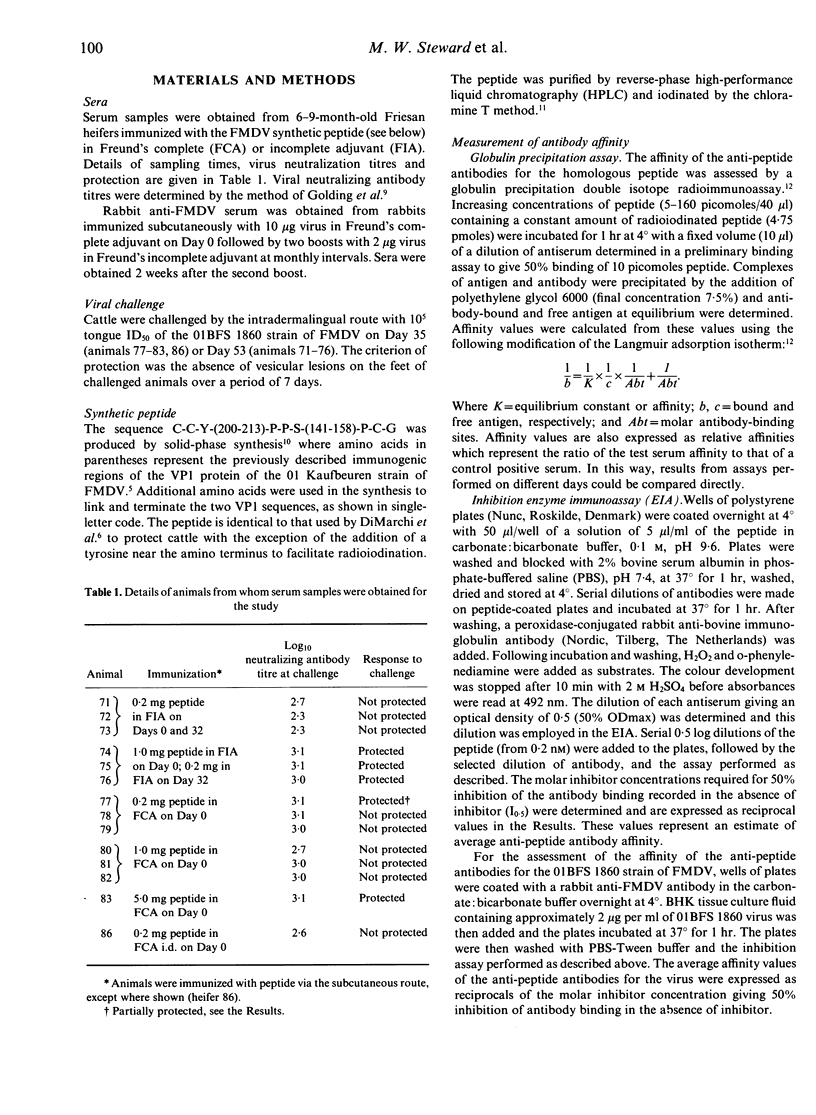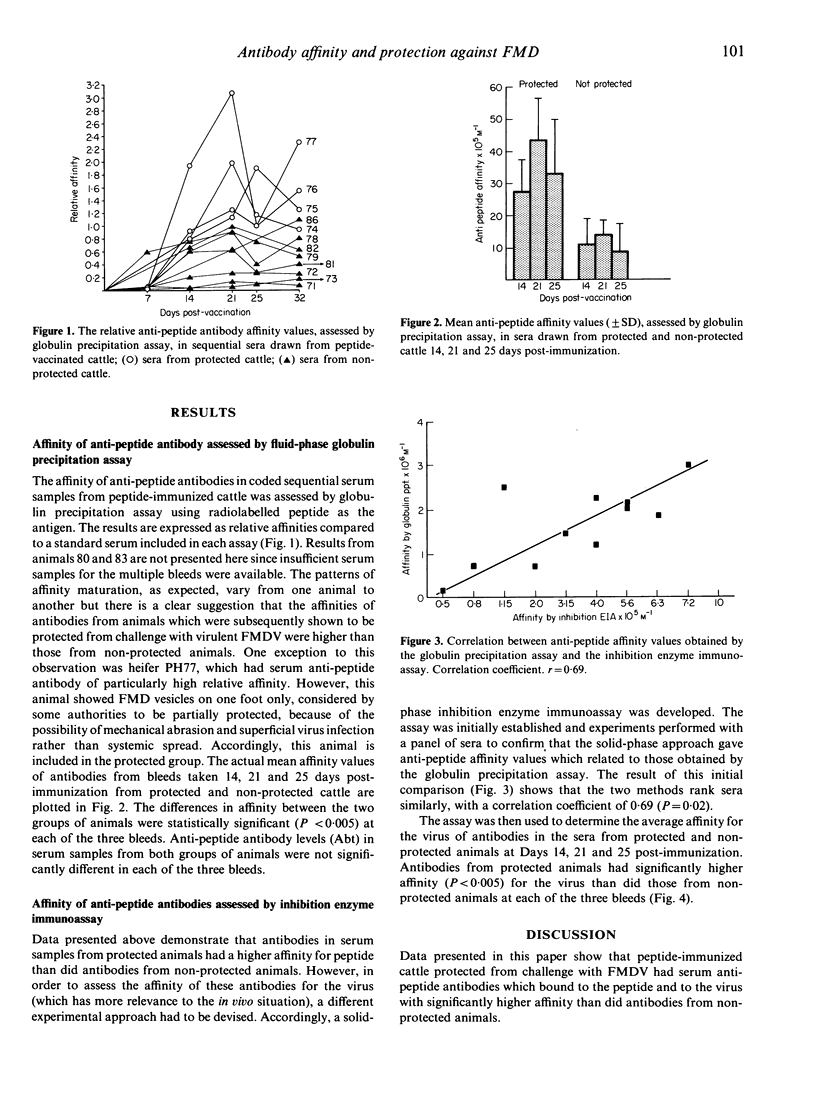Abstract
Previous work has shown that the synthetic peptide C-C-(200-213)-P-P-S-(141-158)-P-C-G, in which residues 200-213 and 141-158 correspond to immunogenic regions of the VP1 protein of foot-and-mouth disease virus (FMDV), is capable of inducing high levels of neutralizing antibody but only inconsistent protection of cattle against virulent FMDV challenge. The possibility exists that differences in affinity may well underlie the observed variations in biological effectiveness of the anti-peptide antibodies in immunized animals. This has been investigated by assessing the affinity for peptide and whole virus of the anti-peptide antibodies in sera from protected and non-protected cattle using both fluid-phase and solid-phase assays. The results obtained show that the affinities of serum antibodies for peptide and virus in protected cattle were significantly higher than those in non-protected animals. Thus in order to assess vaccine efficacy, particularly in the case where synthetic immunogens are employed, consideration should be given to the determination of antibody affinity in addition to other parameters of the antibody response.
Full text
PDF




Selected References
These references are in PubMed. This may not be the complete list of references from this article.
- Beck E., Strohmaier K. Subtyping of European foot-and-mouth disease virus strains by nucleotide sequence determination. J Virol. 1987 May;61(5):1621–1629. doi: 10.1128/jvi.61.5.1621-1629.1987. [DOI] [PMC free article] [PubMed] [Google Scholar]
- Bittle J. L., Houghten R. A., Alexander H., Shinnick T. M., Sutcliffe J. G., Lerner R. A., Rowlands D. J., Brown F. Protection against foot-and-mouth disease by immunization with a chemically synthesized peptide predicted from the viral nucleotide sequence. Nature. 1982 Jul 1;298(5869):30–33. doi: 10.1038/298030a0. [DOI] [PubMed] [Google Scholar]
- Blank S. E., Leslie G. A., Clem L. W. Antibody affinity and valence in viral neutralization. J Immunol. 1972 Mar;108(3):665–673. [PubMed] [Google Scholar]
- DiMarchi R., Brooke G., Gale C., Cracknell V., Doel T., Mowat N. Protection of cattle against foot-and-mouth disease by a synthetic peptide. Science. 1986 May 2;232(4750):639–641. doi: 10.1126/science.3008333. [DOI] [PubMed] [Google Scholar]
- Doel T. R., Baccarini P. J. Thermal stability of foot-and-mouth disease virus. Arch Virol. 1981;70(1):21–32. doi: 10.1007/BF01320790. [DOI] [PubMed] [Google Scholar]
- Fauci A. S., Frank M. M., Johnson J. S. The relationship between antibody affinity and the efficiency of complement fixation. J Immunol. 1970 Jul;105(1):215–220. [PubMed] [Google Scholar]
- Francis M. J., Fry C. M., Rowlands D. J., Brown F. Qualitative and quantitative differences in the immune response to foot-and-mouth disease virus antigens and synthetic peptides. J Gen Virol. 1988 Oct;69(Pt 10):2483–2491. doi: 10.1099/0022-1317-69-10-2483. [DOI] [PubMed] [Google Scholar]
- Golding S. M., Hedger R. S., Talbot P. Radial immuno-diffusion and serum-neutralisation techniques for the assay of antibodies to swine vesicular disease. Res Vet Sci. 1976 Mar;20(2):142–147. [PubMed] [Google Scholar]
- HUNTER W. M., GREENWOOD F. C. Preparation of iodine-131 labelled human growth hormone of high specific activity. Nature. 1962 May 5;194:495–496. doi: 10.1038/194495a0. [DOI] [PubMed] [Google Scholar]
- Holland G. P., Steward M. W. Antibody affinity maturation: the role of CD8+ cells. Clin Exp Immunol. 1989 Dec;78(3):488–493. [PMC free article] [PubMed] [Google Scholar]
- Merrifield R. B., Vizioli L. D., Boman H. G. Synthesis of the antibacterial peptide cecropin A (1-33). Biochemistry. 1982 Sep 28;21(20):5020–5031. doi: 10.1021/bi00263a028. [DOI] [PubMed] [Google Scholar]
- Mulcahy G., Gale C., Robertson P., Iyisan S., DiMarchi R. D., Doel T. R. Isotype responses of infected, virus-vaccinated and peptide-vaccinated cattle to foot-and-mouth disease virus. Vaccine. 1990 Jun;8(3):249–256. doi: 10.1016/0264-410x(90)90054-p. [DOI] [PubMed] [Google Scholar]
- Pay T. W., Hingley P. J. Correlation of 140S antigen dose with the serum neutralizing antibody response and the level of protection induced in cattle by foot-and-mouth disease vaccines. Vaccine. 1987 Mar;5(1):60–64. doi: 10.1016/0264-410x(87)90011-9. [DOI] [PubMed] [Google Scholar]


